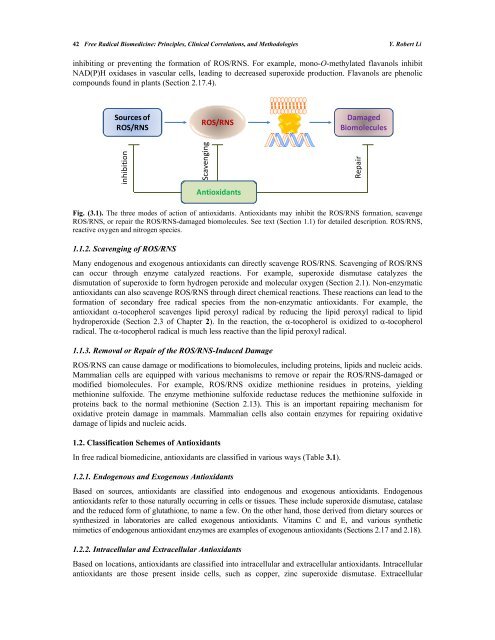Free Radical Biomedicine: Principles, Clinical ... - Bentham Science
Free Radical Biomedicine: Principles, Clinical ... - Bentham Science
Free Radical Biomedicine: Principles, Clinical ... - Bentham Science
Create successful ePaper yourself
Turn your PDF publications into a flip-book with our unique Google optimized e-Paper software.
42 <strong>Free</strong> <strong>Radical</strong> <strong>Biomedicine</strong>: <strong>Principles</strong>, <strong>Clinical</strong> Correlations, and Methodologies Y. Robert Li<br />
inhibiting or preventing the formation of ROS/RNS. For example, mono-O-methylated flavanols inhibit<br />
NAD(P)H oxidases in vascular cells, leading to decreased superoxide production. Flavanols are phenolic<br />
compounds found in plants (Section 2.17.4).<br />
Sources of<br />
ROS/RNS<br />
inhibition<br />
ROS/RNS<br />
Scavenging<br />
Antioxidants<br />
Fig. (3.1). The three modes of action of antioxidants. Antioxidants may inhibit the ROS/RNS formation, scavenge<br />
ROS/RNS, or repair the ROS/RNS-damaged biomolecules. See text (Section 1.1) for detailed description. ROS/RNS,<br />
reactive oxygen and nitrogen species.<br />
1.1.2. Scavenging of ROS/RNS<br />
Many endogenous and exogenous antioxidants can directly scavenge ROS/RNS. Scavenging of ROS/RNS<br />
can occur through enzyme catalyzed reactions. For example, superoxide dismutase catalyzes the<br />
dismutation of superoxide to form hydrogen peroxide and molecular oxygen (Section 2.1). Non-enzymatic<br />
antioxidants can also scavenge ROS/RNS through direct chemical reactions. These reactions can lead to the<br />
formation of secondary free radical species from the non-enzymatic antioxidants. For example, the<br />
antioxidant -tocopherol scavenges lipid peroxyl radical by reducing the lipid peroxyl radical to lipid<br />
hydroperoxide (Section 2.3 of Chapter 2). In the reaction, the -tocopherol is oxidized to -tocopherol<br />
radical. The -tocopherol radical is much less reactive than the lipid peroxyl radical.<br />
1.1.3. Removal or Repair of the ROS/RNS-Induced Damage<br />
ROS/RNS can cause damage or modifications to biomolecules, including proteins, lipids and nucleic acids.<br />
Mammalian cells are equipped with various mechanisms to remove or repair the ROS/RNS-damaged or<br />
modified biomolecules. For example, ROS/RNS oxidize methionine residues in proteins, yielding<br />
methionine sulfoxide. The enzyme methionine sulfoxide reductase reduces the methionine sulfoxide in<br />
proteins back to the normal methionine (Section 2.13). This is an important repairing mechanism for<br />
oxidative protein damage in mammals. Mammalian cells also contain enzymes for repairing oxidative<br />
damage of lipids and nucleic acids.<br />
1.2. Classification Schemes of Antioxidants<br />
In free radical biomedicine, antioxidants are classified in various ways (Table 3.1).<br />
Damaged<br />
Biomolecules<br />
1.2.1. Endogenous and Exogenous Antioxidants<br />
Based on sources, antioxidants are classified into endogenous and exogenous antioxidants. Endogenous<br />
antioxidants refer to those naturally occurring in cells or tissues. These include superoxide dismutase, catalase<br />
and the reduced form of glutathione, to name a few. On the other hand, those derived from dietary sources or<br />
synthesized in laboratories are called exogenous antioxidants. Vitamins C and E, and various synthetic<br />
mimetics of endogenous antioxidant enzymes are examples of exogenous antioxidants (Sections 2.17 and 2.18).<br />
1.2.2. Intracellular and Extracellular Antioxidants<br />
Based on locations, antioxidants are classified into intracellular and extracellular antioxidants. Intracellular<br />
antioxidants are those present inside cells, such as copper, zinc superoxide dismutase. Extracellular<br />
Repair

















